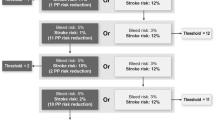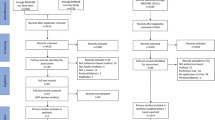Abstract
Decisions regarding the development, regulation, sale, and utilization of pharmaceutical and medical interventions require an evaluation of the balance between benefits and risks. Such evaluations are subject to two fundamental challenges—measuring the clinical effectiveness and harms associated with the treatment, and determining the relative importance of these different types of outcomes. In some ways, determining the willingness to accept treatment-related risks in exchange for treatment benefits is the greater challenge because it involves the individual subjective judgments of many decision makers, and these decision makers may draw different conclusions about the optimal balance between benefits and risks. In response to increasing demand for benefit–risk evaluations, researchers have applied a variety of existing welfare-theoretic preference methods for quantifying the tradeoffs decision makers are willing to accept among expected clinical benefits and risks. The methods used to elicit benefit–risk preferences have evolved from different theoretical backgrounds. To provide some structure to the literature that accommodates the range of approaches, we begin by describing a welfare-theoretic conceptual framework underlying the measurement of benefit–risk preferences in pharmaceutical and medical treatment decisions. We then review the major benefit–risk preference-elicitation methods in the empirical literature and provide a brief overview of the studies using each of these methods. The benefit–risk preference methods described in this overview fall into two broad categories: direct-elicitation methods and conjoint analysis. Rating scales (6 studies), threshold techniques (9 studies), and standard gamble (2 studies) are examples of direct elicitation methods. Conjoint analysis studies are categorized by the question format used in the study, including ranking (1 study), graded pairs (1 study), and discrete choice (21 studies). The number of studies reviewed here demonstrates that this body of research already is substantial, and it appears that the number of benefit–risk preference studies in the literature will continue to increase. In addition, benefit–risk preference-elicitation methods have been applied to a variety of healthcare decisions and medical interventions, including pharmaceuticals, medical devices, surgical and medical procedures, and diagnostics, as well as resource-allocation decisions such as facility placement. While preference-elicitation approaches may differ across studies, all of the studies described in this review can be used to provide quantitative measures of the tradeoffs patients and other decision makers are willing to make between benefits and risks of medical interventions. Eliciting and quantifying the preferences of decision makers allows for a formal, evidence-based consideration of decision-makers’ values that currently is lacking in regulatory decision making. Future research in this area should focus on two primary issues—developing best-practice standards for preference-elicitation studies and developing methods for combining stated preferences and clinical data in a manner that is both understandable and useful to regulatory agencies.


Similar content being viewed by others
References
Cioms, IV Working Group. Benefit–risk balance for marketed drugs: evaluating safety signals. Report of the CIOMS Working Group IV. Geneva: Council for International Organizations of Medical Sciences; 1998.
Lynd L, O’Brien BJ. Advances in risk-benefit evaluation using probabilistic simulation methods: an application to the prophylaxis of deep vein thrombosis. J Clin Epidemiol. 2004;57(8):795–803.
Van Houtven G, Johnson FR, Kilambi V, Hauber AB. Eliciting benefit–risk preferences and probability-weighted utility using choice-format conjoint analysis. Med Decis Making. 2011;31(3):469–80.
Ho M, Lavery B, Pullar T. The risk of treatment. A study of rheumatoid arthritis patients’ attitudes. Br J Rheumatol. 1998;37(4):459–60.
Pullar T, Wright V, Feely M. What do patients and rheumatologists regard as an ‘acceptable’ risk in the treatment of rheumatic disease? Br J Rheumatol. 1990;29(3):215–8.
Bremnes RM, Andersen K, Wist EA. Cancer patients, doctors and nurses vary in their willingness to undertake cancer chemotherapy. Eur J Cancer. 1995;31A(12):1955–9.
Barker JH, Furr A, Cunningham M, Grossi F, Vasilic D, Storey B, et al. Investigation of risk acceptance in facial transplantation. Plast Reconstr Surg. 2006;118(3):663–70.
Majzoub RK, Cunningham M, Grossi F, Maldonado C, Banis JC, Barker JH. Investigation of risk acceptance in hand transplantation. J Hand Surg Am. 2006;31(2):295–302.
Reynolds CC, Martinez SA, Furr A, Cunningham M, Bumpous JM, Lentsch EJ, et al. Risk acceptance in laryngeal transplantation. Laryngoscope. 2006;116(10):1770–5.
Devereaux PJ, Anderson DR, Gardner MJ, Putnam W, Flowerdew GJ, Brownell BF, et al. Differences between perspectives of physicians and patients on anticoagulation in patients with atrial fibrillation: observational study. BMJ. 2001;323(7323):1218–22.
Kopec JA, Richardson CG, Llewellyn-Thomas H, Klinkhoff A, Carswell A, Chalmers A. Probabilistic threshold technique showed that patients’ preferences for specific trade-offs between pain relief and each side effect of treatment in osteoarthritis varied. J Clin Epidemiol. 2007;60(9):929–38.
Richardson CG, Chalmers A, Llewellyn-Thomas HA, Klinkhoff A, Carswell A, Kopec JA. Pain relief in osteoarthritis: patients’ willingness to risk medication-induced gastrointestinal, cardiovascular, and cerebrovascular complications. J Rheumatol. 2007;34(7):1569–75.
Llewellyn-Thomas HA, Arshinoff R, Bell M, Williams JI, Naylor CD. In the queue for total joint replacement: patients’ perspectives on waiting times. Ontario Hip and Knee Replacement Project Team. J Eval Clin Pract. 1998;4(1):63–74.
Finlayson SR, Birkmeyer JD, Tosteson AN, Nease RF Jr. Patient preferences for location of care: implications for regionalization. Med Care. 1999;37(2):204–9.
Palda VA, Llewellyn-Thomas HA, Mackenzie RG, Pritchard KI, Naylor CD. Breast cancer patients’ attitudes about rationing postlumpectomy radiation therapy: applicability of trade-off methods to policy-making. J Clin Oncol. 1997;15(10):3192–200.
Llewellyn-Thomas HA, Williams JI, Levy L, Naylor CD. Using a trade-off technique to assess patients’ treatment preferences for benign prostatic hyperplasia. Med Decis Making. 1996;16(3):262–82.
Simes RJ, Coates AS. Patient preferences for adjuvant chemotherapy of early breast cancer: how much benefit is needed? J Natl Cancer Inst Monogr. 2001;30:146–52.
Llewellyn-Thomas HA, Paterson JM, Carter JA, Basinski A, Myers MG, Hardacre GD, Dunn EV, D’Agostino RB, Naylor CD. Primary prevention drug therapy: can it meet patients’ requirements for reduced risk? Med Decision Making. 2002;22:326–39.
O’Brien BJ, Elswood J, Calin A. Willingness to accept risk in the treatment of rheumatic disease. J Epidemiol Community Health. 1990;44(3):249–52.
Thompson MS. Willingness to pay and accept risks to cure chronic disease. Am J Public Health. 1986;76(4):392–6.
Fraenkel L, Bodardus S, Wittnik DR. Understanding patient preferences for the treatment of lupus nephritis with adaptive conjoint analysis. Med Care. 2001;39(11):1203–16.
Sassi F, McKee M. Do clinicians always maximize patient outcomes? A conjoint analysis of preferences for carotid artery testing. J Health Serv Res Policy. 2008;13(2):61–6.
Johnson FR, Ozdemir S, Hauber B, Kauf TL. Women’s willingness to accept perceived risks for vasomotor symptom relief. J Womens Health. 2007;16(7):1028–40.
de Bekker-Grob EW, Essink-Bot ML, Meerding WJ, Pols HA, Koes BW, Steyerberg EW. Patients’ preferences for osteoporosis drug treatment: a discrete choice experiment. Osteoporos Int. 2008;19(7):1029–37.
Eberth B, Watson V, Ryan M, Hughes J, Barnett G. Does one size fit all? Investigating heterogeneity in men’s preferences for benign prostatic hyperplasia treatment using mixed logit analysis. Med Decis Making. 2009;29(6):707–15.
McTaggart-Cowan HM, Shi P, Fitzgerald JM, Anis AH, Kopec JA, Bai TR, et al. An evaluation of patients’ willingness to trade symptom-free days for asthma-related treatment risks: a discrete choice experiment. J Asthma. 2008;45(8):630–8.
Salkeld G, Solomon M, Short L, Ryan M, Ward JE. Evidence-based consumer choice: a case study in colorectal cancer screening. Aust N Z J Public Health. 2003;27(4):449–55.
Johnson FR, Ozdemir S, Mansfield C, Hass S, Miller DW, Siegel CA, et al. Crohn’s disease patients’ risk-benefit preferences: serious adverse event risks versus treatment efficacy. Gastroenterology. 2007;133(3):769–79.
Fraenkel L, Gulanski B, Wittink D. Patient willingness to take teriparatide. Patient Educ Couns. 2007;65(2):237–44.
Hauber AB, Johnson FR, Grotzinger KM, Ozdemir S. Patients’ benefit–risk preferences for chronic idiopathic thrombocytopenic purpura therapies. Ann Pharmacother. 2010;44(3):479–88.
Mohamed AF, Johnson FR, Hauber AB, Lescrauwaet B, Masterson A. Physicians’ stated trade-off preferences for chronic hepatitis B treatment outcomes in Germany, France, Spain, Turkey, and Italy. Eur J Gastroenterol Hepatol. 2012;24(4):419–26.
Lewis SM, Cullinane FN, Bishop AJ, Chitty LS, Marteau TM, Halliday JL. A comparison of Australian and UK obstetricians’ and midwives’ preferences for screening tests for down syndrome. Prenat Diagn. 2006;26(1):60–6.
Bridges JF, Mohamed AF, Finnern HW, Woehl A, Hauber AB. Patients’ preferences for treatment outcomes for advanced non-small cell lung cancer: a conjoint analysis. Lung Cancer. 2012;77(1):224–31.
Hauber AB, Johnson FR, Fillit H, Mohamed AF, Leibman C, Arrighi HM, Grundman M, Townsend RJ. Older Americans’ risk-benefit preferences for modifying the course of Alzheimer disease. Alzheimer Dis Assoc Disord. 2009;23(1):23–32.
Johnson FR, Hauber AB, Ozdemir S, Lynd L. Quantifying women’s stated benefit–risk trade-off preferences for IBS treatment outcomes. Value Health. 2010;13(4):418–23.
Johnson FR, Hauber B, Ozdemir S, Siegel CA, Hass S, Sands BE. Are gastroenterologists less tolerant of treatment risks than patients? Benefit–risk preferences in Crohn’s disease management. J Manag Care Pharm. 2010;16(8):616–28.
Johnson FR, Ozdemir S, Mansfield C, Hass S, Siegel CA, Sands BE. Are adult patients more tolerant of treatment risks than parents of juvenile patients? Risk Anal. 2009;29(1):121–36.
Johnson FR, Van Houtven G, Ozdemir S, Hass S, White J, Francis G, et al. Multiple sclerosis patients’ benefit–risk preferences: serious adverse event risks versus treatment efficacy. J Neurol. 2009;256(4):554–62.
Mohamed AF, Hauber AB, Neary MP. Patient benefit–risk preferences for targeted agents in the treatment of renal cell carcinoma. Pharmacoeconomics. 2011;29(11):977–88.
Wong MK, Mohamed AF, Hauber AB, Yang JC, Liu Z, Rogerio J, Garay CA. Patients rank toxicity against progression free survival in second-line treatment of advanced renal cell carcinoma. J Med Econ. 2012;15(6):1139–48.
Ratcliffe J, Buxton M. Patients’ preferences regarding the process and outcomes of life-saving technology. An application of conjoint analysis to liver transplantation. Int J Technol Assess Health Care. 1999;15(2):340–51.
Ratcliffe J, Buxton M, McGarry T, Sheldon R, Chancellor J. Patients’ preferences for characteristics associated with treatments for osteoarthritis. Rheumatology (Oxford). 2004;43(3):337–45.
Arden NK, Hauber AB, Mohamed AF, Johnson FR, Peloso PM, Watson DJ, et al. How do physicians weigh benefits and risks associated with treatments in patients with osteoarthritis in the United Kingdom? J Rheumatol. 2012;39(5):1056–63.
Hauber AB, Mohamed AF, Watson ME, Johnson FR, Hernandez JE. Benefits, risk, and uncertainty: preferences of antiretroviral-naive African Americans for HIV treatments. AIDS Patient Care STDS. 2009;23(1):29–34.
European Medicines Agency (2010) Road map to 2015. http://www.ema.europa.eu/docs/en_GB/document_library/Report/2011/01/WC500101373.pdf. Accessed 15 April 2012.
Maxmen A. Law spurs regulator to heed patients’ priorities. Nature. 2012;487(7406):154. doi:10.1038/487154a.
Holden WL. Benefit–risk analysis: a brief review and proposed quantitative approaches. Drug Saf. 2003;26(12):853–62.
Lynd LD, Naiafzadeh M, Colley L, Byrne MF, Willan AR, Sculpher MJ, Johnson FR, Hauber AB. Using the incremental net benefit framework for quantitative benefit–risk analysis in regulatory decision making—a case study of alosetron in irritable bowel syndrome. Value Health. 2010;13(4):411–7.
Glickman TS, Gough M. Readings in risk. Washington, DC: Resources for the Future; 1990.
Kahneman D, Tversky A. Choices, values, and frames. Oxford: Cambridge University Press; 2000.
Acknowledgments
The authors received no direct funding for this manuscript, and declare no financial conflicts of interest.
Author Contributions
A. Brett Hauber led all aspects of this study, including defining the objectives of the research, defining the search strategy, developing criteria for study inclusion, reviewing studies, and writing the manuscript. A. Brett Hauber also contributed to developing the conceptual model. Angelyn O. Fairchild conducted the literature search and contributed to defining the search strategy, developing criteria for study inclusion, reviewing studies, and writing the manuscript. F. Reed Johnson contributed to defining the objectives of the research and developing the conceptual model and writing the manuscript. A. Brett Hauber had access to all data and take full responsibility for the content of this manuscript.
Author information
Authors and Affiliations
Corresponding author
Rights and permissions
About this article
Cite this article
Brett Hauber, A., Fairchild, A.O. & Reed Johnson, F. Quantifying Benefit–Risk Preferences for Medical Interventions: An Overview of a Growing Empirical Literature. Appl Health Econ Health Policy 11, 319–329 (2013). https://doi.org/10.1007/s40258-013-0028-y
Published:
Issue Date:
DOI: https://doi.org/10.1007/s40258-013-0028-y




